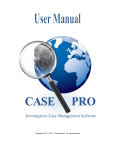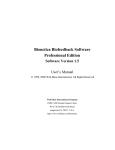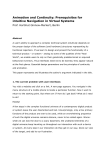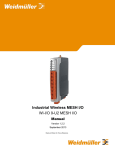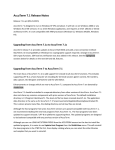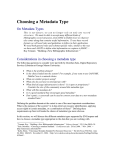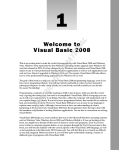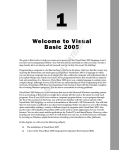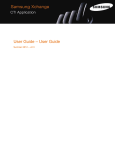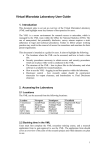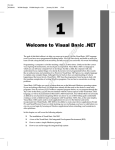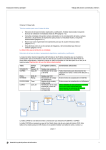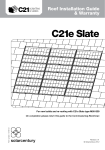Download full project - sjhoward.co.uk The
Transcript
Simon Howard Page 0 Newtown Hospital Radio A2 Computing Project 2001/2002 Simon Howard Page 1 Contents Contents.........................................................................................................................1 Analysis .........................................................................................................................3 Background to the problem ........................................................................................3 Identification of the problem......................................................................................3 Identification of the prospective users .......................................................................4 Identification of User Needs ......................................................................................4 Realistic Appraisal of the Feasibility of Potential Solutions......................................5 Justification of chosen solution ..................................................................................6 Data source(s) and destination(s), logical DfDs, and an E-R model..........................6 Objectives of the Project ............................................................................................9 Design ..........................................................................................................................11 Overall system design ..............................................................................................11 Modular Structure of System ...................................................................................12 Data Requirements ...................................................................................................12 Storage Media and Format .......................................................................................13 Algorithms................................................................................................................13 Validation .................................................................................................................14 User Interface Design...............................................................................................14 Data Capture and Entry ............................................................................................17 Record / Database Structure.....................................................................................18 Output.......................................................................................................................18 Database Design: E-R Model..................................................................................19 Security and Integrity of Data ..................................................................................20 System Security........................................................................................................20 Test Strategy.............................................................................................................20 Technical Solution ......................................................................................................22 Annotated Program Listings.....................................................................................22 Screen Designs .........................................................................................................22 Database Structure....................................................................................................24 How the technical solution was achieved ................................................................25 System Testing ............................................................................................................26 Typical Testing.........................................................................................................26 Extreme and Erroneous Testing ...............................................................................31 Corrections Resulting from Failed Tests..................................................................33 Testing: Screen Dumps ............................................................................................34 Screen Dump 1: The Main Menu ........................................................................34 Screen Dump 2: The Password Entry Window ...................................................34 Screen Dump 3: The Edit Track Details Screen .................................................34 Screen Dump 4: The Edit Bookings Screen ........................................................35 Screen Dump 5: The Reports Window ................................................................35 Screen Dump 6: Adding a Member (Access Tables)...........................................36 Screen Dump 7: Adding a Track to a Record (Access Tables) ...........................36 Screen Dump 8: Deleting a Track (Access Tables).............................................37 Simon Howard Page 2 Screen Dump 9: Adding a Member (Access Tables)...........................................37 Screen Dump 10: Deleting a Member (Access Tables).......................................37 Screen Dump 11: Editing a Member (Access Tables).........................................38 Screen Dump 12: Searching for Member Details ...............................................38 Screen Dump 13: Changing the Password (Access Tables) ...............................39 Screen Dump 14: Adding a Track (Access Tables).............................................39 Screen Dump 15: Deleting a Track (Access Tables)...........................................39 Screen Dump 16: Editing a Track (Access Tables).............................................40 Screen Dump 17: Searching for a Track.............................................................40 Screen Dump 18: Incorrect Password Error Message .......................................41 Screen Dump 19: No More Results Error Message............................................41 Screen Dump 20: Invalid Record Number Error Message .................................41 Screen Dump 21: Invalid Track Length Error Message .....................................41 System Maintenance ..................................................................................................42 Access Features Used...............................................................................................42 Visual Basic Features Used......................................................................................42 Detailed Algorithm Design ......................................................................................42 Disabling and hiding irrelevant command buttons and labels ............................42 Find a Member: Case Insensitive........................................................................42 Find a member: Case Sensitive...........................................................................43 Re-enabling relevant command buttons and labels .............................................43 Searching for Tracks ............................................................................................44 Program Code...........................................................................................................45 Procedures and Variables .........................................................................................45 User Manual................................................................................................................46 Introduction ..............................................................................................................46 Installation ................................................................................................................46 Screen Displays ........................................................................................................46 Error Messages .........................................................................................................49 Known Problems and Limitations............................................................................50 Appraisal ....................................................................................................................... i Project Performance against Analysis Objectives and Possible Extensions .............. i User Feedback ........................................................................................................... ii Appendix A: Complete Program Listings Appendix B: Sample Report Printouts Appendix C: User Feedback Simon Howard Analysis Page 3 Analysis Background to the problem Newtown Hospital Radio is a voluntary organisation, and a registered charity. They broadcast music shows, as well as some talk shows, to Newtown and Formby District General Hospital twenty-four hours a day. There are three groups of volunteers who work at the hospital radio: The support staff, the presenters, and the executives. The support staff completes the more menial tasks that are, nonetheless, essential to maintaining the hospital radio. These tasks include visiting the wards to get requests from patients, keeping the studio clean and tidy, and keeping the record library in order. Also, technical support staff must keep all of the studio equipment in full working order. There are more specific support staff, too, such as the secretary and the treasurer, who complete all the more demanding jobs at the station. The presenters are responsible for recording a new edition of their show every week onto MiniDisc. Each show is played several times each week, so that the presenters do not have to record too much material. The executives are in charge of the radio station. The executives are made up of elected representatives from each of the groups of volunteers, as well as a chairperson. They are responsible for all of the major decisions about the running of the radio station. I have chosen to base my project on the Newtown Hospital Radio as I have worked with them in the past on many different projects, and because they are desperately in need of a new system to replace the current one. Identification of the problem Currently, an index of the record library is kept using a system of index cards. One set of cards is arranged in alphabetical order of song title, and one set is arranged in alphabetical order of artist. However, the number of items in the record library is beginning to grow to such a level that an index card system is rather impractical. Also, if a request for a specific song is made, but neither the full title or artist’s name is known, then the song cannot be found. Member’s details are also currently kept in an index card system. There are also several problems with this system. For example, if a member of Support Staff needs to be contacted, then the secretary must look though the cards (which are arranged in alphabetical order of name) until a member of Support Staff is found. Also, if all executives are to be contacted, then the entire index card system must be browsed to find those members who are on the executive committee. As the number of members grows, this is getting to be rather time-consuming. Also, it is inevitable that index Simon Howard Analysis Page 4 cards go missing, as people remove them to copy out an address or a phone number, and then forget to replace them. This makes the whole system totally inaccurate. Twenty-four hour broadcasting is a new venture for Newtown Hospital Radio, and has required an increase in the number of presenters. Previously, presenters were allowed to record their shows in the studio whenever they had a spare hour. But, as more presenters are recruited, several have arrived to record their show at the same time. This has led to a number of disagreements within the organisation, and, ultimately, several presenters have moved to other hospital radio stations. Currently, no system is in place to deal with this problem. The data that I will use in my systems once they have been constructed can be easily researched from the current index card system. Identification of the prospective users There will be many different users of the new system, since all support staff and presenters will need to be able to find records using the system, and all presenters will need to be able to book time in the studio to record their shows. Also, executives may need to access the member database to communicate with volunteers. Therefore, there will be many different users with varying degrees of computer experience. Therefore, the system will have to be very user friendly, since some users have never have tried to operate a computer before, and few have the time to be trained how to use it. Operation of the system must therefore be clear, so that most people will be able to operate it without training. Identification of User Needs The system must be able to do the following: • Store and allow update and deletion of information about each song in the record library o Track ID (So that it can be found in record library). Track ID is made up of a four digit number (MiniDisc number), followed by a dash, and then a two digit number (Track Number) o Track Title o Artist o Style of music (Jazz, pop etc.) o Length of track • Find a track or tracks by searching on any of the above criteria. The results of this search will be displayed on the screen for immediate reference. Hard copies would not be beneficial since the majority of presenters plan their shows from the studio. • Allow the user to browse through the songs available and view details of any chosen song. • Store and allow update and deletion of information about each member o Name o Address Simon Howard • • • • • Analysis Page 5 o Telephone Number o Status (Support / Presenter / Executive Support / Executive Presenter) Find a member or members by searching on any of the above criteria. Again, the results of this search will be displayed onscreen. Allow the user to browse through a database of members view the details of any chosen member. Allow a presenter (and only a presenter) to book an hour when they can use the studio. Although not originally suggested, after discussion with current members, a system whereby a data sheet of bookings could be printed has now been suggested. Therefore, my system will also allow the printing of a list of bookings made by members. Also, a list of tracks that each presenter wants to use during their booked time will be stored, and printed on the booking data sheet. Print members’ details ordered by status should be available, as this could serve as a useful telephone directory. Print a list of all of the tracks in the music database should also be made available, so that the few presenters who choose to plan some of their shows at home are catered for. I will complete this task by using a Microsoft Access Database, fronted by a Visual Basic program. This way, I will be able to customise the look and feel of the way in which the database is accessed, and I will be able to do much of the complicated searching and querying “Behind the scenes”, thus making the system very easy to operate. There are relatively constraints placed upon the system, as Newtown Hospital Radio is equipped with a computer and Microsoft Office. Since the database is never, at least in the foreseeable future, going to reach millions of data items stored, then processing power is not going to cause too much of a problem, as the system is fairly up-to-date and has a powerful processor. Also, the 20Gb hard disk should be ample for this system. All of the hardware needed to run my system is clearly available. A backup is already made of the system on a weekly basis, as the computer is currently used by the secretary for typing letters. Backups are made on Zip Discs, which are then stored at another location (the secretary’s house). Using specialist software, the technical manager is able to remotely take control of the computer from home, so that any problems with the system can easily be fixed (the technical manager is computer literate). Realistic Appraisal of the Feasibility of Potential Solutions There would be many ways of approaching this project, using software and programming languages as described below: • Pascal: A program could be written in Pascal to handle the above data. • Access: Microsoft Access could have been used on its own, without any fronting being completed by a Visual Basic program. • Excel: Microsoft Excel could be used to store the data. • Basic: A program could be written in Basic to handle the data Simon Howard • Analysis Page 6 Manual: A manual system, with a few modifications and additions to the current manual system, could be used to store the data. Justification of chosen solution I chose not to complete the project using the above solutions for these reasons: • I did not want to complete the system in Pascal or Delphi, since a user interface with which the majority of people would be familiar (i.e. a Windowsstyle interface) would be very difficult to create using this programming language. • I did not want to complete the project using Microsoft Access alone, as this would have made it very difficult to present the user with an interface that is easy to understand. It would, realistically, have meant that the user would have to be familiar with writing Microsoft Access queries. Although, theoretically, a user can be protected from this by using Microsoft Access’s own programming language, this is extremely difficult, and would probably have resulted in a very high maintenance system. • The project could not practically be completed in Microsoft Excel. Again, attempting to build a system of this scale in Microsoft Excel would make it very difficult to present an easy-to-use, intuitive user interface, since many advanced options, which the user does not need to use, would be ever present. • Basic has the same inherent problems as Pascal: It is very difficult to build a windows-style environment using this language. • A manual system would not be able to fulfil all of the criteria set out for the new system, since it would be impossible to search a manual system. Furthermore, a computerised system can have regular backups made with greater ease, and security of information can be improved. Also, presentation of printed material is far better than presentation of hand-written material, and can reduce error (e.g. when information about a record is copied from an index card, it is very easy to incorrectly copy the record number, which ultimately results in the user being unable to find the record.) I have chosen to complete my project in Visual Basic and Microsoft Access as I familiar with these, and a suitable system can be built using them. I will also be able to decide exactly what I want to show to the user, and so will be able to hide any unnecessary options from the user, whilst still maintaining a windows style. There are, however, some disadvantages of my system. For example, those with absolutely no computer experience will need training in its operation. However, since the computer software is already in place, I do not think that the new system will be any more expensive than the current one. Data source(s) and destination(s), logical DfDs, and an E-R model For this section, it seems logical to split the project into three separate sections: • Record database • Member database Simon Howard • Analysis Page 7 Booking system In the record database, the data that comes from the cover of the MiniDisc is entered into the manual database, for retrieval at a later date by a presenter or member of support staff: Process Track details MiniDisc cover Record Details files Track details Relevant Track details Presenter or Support Volunteer Browse track data The new system will be much the same, but only one Record Details file will be kept. Also, searches and validation will take place: MiniDisc cover Track details Relevant valid track details Presenter or Support Volunteer Validate track details Valid track details Record Details file Valid Track details Browse or Search track data Currently, the member database is very similar to the record database in terms of data flow: Simon Howard Analysis Page 8 Member details Process Member Details Membership form Member Details file Member Relevant member details Person who needs member details details Browse member details However, the new system will have a slightly more complicated method of data flow, as a booking system is to be added. The entity relationships for this system will be as follows: Booking makes Member associated with Track Thus, one presenter could, in theory, have more than one booking per week. The data flow in the proposed system will be as follows: Simon Howard Membership form Person who needs member details Bookings file Analysis Member details Relevant member details Validate member details Browse member details Complete booking details Process booking Page 9 Valid Member details Valid Member details Member Details file Valid Member details Valid booking details Validate booking details Booking details Records file Booking form Objectives of the Project The objectives of this project are to fulfil the users’ needs by producing a system that can: • Store and allow update and deletion of information about each song in the record library o Track ID (So that it can be found in record library). Track ID is made up of a four digit number (MiniDisc number), followed by a dash, and then a two digit number (Track Number) o Track Title o Artist o Style of music (Jazz, pop etc.) o Length of track • Find a track or tracks by searching on any of the above criteria. The results of this search will be displayed on the screen for immediate reference. Hard copies would not be beneficial since the majority of presenters plan their shows from the studio. • Allow the user to browse through the songs available and view details of any chosen song. • Store and allow update and deletion of information about each member Simon Howard • • • • • Analysis Page 10 o Name o Address o Telephone Number o Status (Support / Presenter / Executive Support / Executive Presenter) Find a member or members by searching on any of the above criteria. Again, the results of this search will be displayed onscreen. Allow the user to browse through a database of members view the details of any chosen member. Allow a presenter (and only a presenter) to book an hour when they can use the studio. Although not originally suggested, after discussion with current members, a system whereby a data sheet of bookings could be printed has now been suggested. Therefore, my system will also allow the printing of a list of bookings made by members. Also, a list of tracks that each presenter wants to use during their booked time will be stored, and printed on the booking data sheet. Print members’ details ordered by status should be available, as this could serve as a useful telephone directory. Print a list of all of the tracks in the music database should also be made available, so that the few presenters who choose to plan some of their shows at home are catered for. Simon Howard Design Page 11 Design Overall system design My system will not be entirely automatic – some manual processed will obviously be required. However, the manual processes should work together with the computerised processes should work together efficiently to provide a full working solution. I will construct the system to allow dataflow in this pattern: Collection of Track Details Collection of Member Details Track Details Member Details Keyboard Keyboard Validation Validation Track Details File Member Details File Booking Details Keyboard Process Booking Output request entered Process request Requested output document (Maybe onscreen or hard copy) Booking Details File Simon Howard Design Page 12 Modular Structure of System The system as shown in the system flow chart can be thought of as being made up of several different modules, each with its own section of coding. These are: • • • Validation Modules: There are two independents validation modules which are the ones which validate the entry of data about members and tracks. However, there a further validation module will be “built in” to the Process Booking module, to ensure that only valid bookings are made. For more information on the validation process, see “Validation” on page 14. Process Bookings Module: This will take data from both the Member and Music files in order to build up and store a valid booking. Search Modules: These will have their own algorithms to search the databases for the relevant information. For more information on the algorithms, see “Algorithms” on page 14. Other parts of the system, which cannot be truly referred to as “Modules”, are also necessary. These manual processes are: • • Collection of Track Details: This involves the typing in of details about each track. More information can be found in “Data Capture and Entry” on page 17. Collection of Member Details: This involves the typing in of details about each member, and keeping these details up to date. More information can be found in “Data Capture and Entry” on page 17. Data Requirements The best way to express the data requirements of the system is in a data dictionary. Table Name Music Description Holds data about the music collection Name Holds data about the members Length ID Track ID (Already implemented). Primary Key. Text 7 Title Title of piece of music Text 30 Genre The type of music stored The artist or composer of a piece of music. The length of the given track in seconds. A unique member ID. Primary Key. Text 10 Text 30 Artist Length Members Description Field Data Type ID Default Value Validation Must be of the format 0000-00 Must be between 1 and 3600. Integer Text Name Member Name Text 30 Address Line 1 Member’s Address Line 1 Text 50 Address Line 2 Member’s Address Line 2 Text 50 Address Line 3 Member’s Address Line 3 Text 50 Simon Howard Bookings Page 13 Postcode Member’s Postcode Text 8 Phone Member’s Phone Number Text 12 Status Member’s Status BookerID Hold details about studio bookings Design Tracks Time Date Member ID of person who booked the studio. Series of Track IDs associated with this booking. Time of booking (Start of 1hr slot). Combined primary key with date. Date of booking. Combined primary key with time. The member must be a presenter Integer Text 140 Time Date Because of the many-to-many relationship involved in this data, a separate “link” table containing the fields Date, Time and Track ID will be necessary to normalise the database. The E-R model can then be constructed as shown in “Database Design: ER Model” on page 19. Storage Media and Format The data will be stored as Access Database files, and will be stored on the computer’s hard drive, and backed up regularly onto Zip Disc. Storing the files as Access Database files is the most practical solution, since I will be accessing the files from Visual Basic via Microsoft Access. Since these files are of a recognised and widely used file format, they will also be easy to use with other programs if the system is changed in the future. In terms of a volumetric calculation: The “Music” table could have up to about 70 characters => 70 bytes per record and will hold approximately 2000 records => 140kB The “Members” table could have up to about 150 characters => 180 bytes per record and will hold approximately 30 records => 4.5kB The “Bookings” table could have up to about 150 characters => 150 bytes per record and about 20 records will be added per week => 3.6kB added per week => 187.2kB added per year Therefore, the database cannot be expected to grow over about 350kB over a year, or 2.5MB over ten years. Therefore, the 20Gb hard drive is ample. Algorithms The main algorithms used in the project will be those for the searches. The search algorithms will be so similar that it only seems worth including one of them at this stage, since they will be fully documented in the program listings. Therefore, I have only included the algorithm for the search of the member database: Dim sql As String Simon Howard Design Page 14 sql = “SELECT * From Client WHERE (((UCASE(Client.ClientId)) Like ‘%?%’));” sql = Replace (sql, “?”. Ucase(txtSearchFor.Text)) adoClients.RecordSource = sql adoClients.Refresh Validation The validation procedures will validate the data as detailed in the data dictionary in “Data Requirements” on page 12. I will leave the error handling to Access, as I do not feel that there is any way in which I can improve upon the error handling provided. However, to reassure the user, I will intercept the default error message with my own, as new users may not understand those provided by Access. I will also put the incorrect field in focus so that the user can correct it. The error message will be a VB message box, and so will look something like this: X Track length invalid The track length you entered is invalid. OK User Interface Design In order to navigate the system, menus will be used. Before looking in detail at the form design of the menus, it is logical to look at the menu structure as a whole. This is shown below. I have designed it to be as logical and intuitive as possible, so that each part of the program is easy to find. The menu structure is shown here: File Exit Edit Bookings Member Details Music Database View Bookings Member Details Music Database Reports Help About Member Status Report Phone Number Report Clicking on the large command buttons to navigate the system will take the user directly to the editing dialog as relevant. This will mean that the less computer- Simon Howard Design Page 15 literate users will have access to all the data without becoming confused over more complex features such as reports. The menu forms will look like this: X Hospital Radio File Edit View Main Menu Member Details Music Database Bookings Exit The Member Details form will be designed like this: Simon Howard Design Page 16 X Hospital Radio Member Details Member ID: Name: Phone: Address: Status: Support Add Delete Search Main Menu When the form loads, the first member’s details will be displayed in the text boxes. Changing the details as displayed on the screen will edit the database. This system will also be used in the music database: Hospital Radio X Music Database Track ID: Track Name: Artist: Length (sec): Style: Classical Add Delete Search Main Menu Simon Howard Design Page 17 The bookings display will need to be slightly different, but the same principle will apply in that the first booking will be displayed when the form is loaded. The form will be designed to look like this: X Hospital Radio Bookings Booking ID: Presenter ID and Name: Tracks reserved: Date (dd/mm/yyyy): Time (Start): Add Delete Search Main Menu In order to maintain consistency throughout the program, all of the search dialogs will be designed to appear similar. They will all look like this: X Search Search for: Case Sensitive Find First Find Next Cancel The reports will appear in Visual Basic’s default report window. The reports themselves are discussed in “Output” on page 18. Data Capture and Entry For the data capture of the member details, a new member data capture form, which has been tried and tested over several years is already in place, and I see no good Simon Howard Design Page 18 reason to change this. This form is given to all new members, so that their personal information can be recorded. They are required to inform the secretary of any changes to their information, and so the secretary can then update the new system in the same way that he currently updates the system in place at the moment. The data will be entered through the system which I have designed by navigating to the Member details screen and clicking “Add”. The relevant information can then be entered via the keyboard. The data for the music database can be found on the cover of the Minidisks, and is currently entered into the old system by support staff. There seems no valid reason to change this system, so the support staff can continue to enter the information by typing it into the new system. To do this, they will simply need to navigate to the “Music Database” form and click “Add”. They will then be able to enter the data for the new track to add it to the database. For the bookings system, the presenter who wishes to book the studio can simply enter the relevant information into the system when they are at the studio. Alternatively, they could phone the studio and someone could enter the booking information for them. Record / Database Structure The database will be made up of three tables: Music(ID, Title, Artist, Length), Members(ID, Name, Address, Status) and Booking(ID, BookerID, Tracks, Time, Date). For more information on these, see the data dictionary under “Data Requirements” on page 12. Output The hard output from the system will consist of several reports which can be printed if the user so wishes, or alternatively just viewed on the screen. The printed output will look like this: Simon Howard Design Page 19 Member Status Report Glenn Howard Executive Presenter 01704 245992 Stuart McDowell Executive Presenter 01704 247546 Elaine Goy Executive Presenter 01704 247521 10 Birchtree Avenue Newtown PR3 4RT 45 Greenwood Place Newtown PR5 7RY 47 Greenwood Place Newtown PR5 7RY Total Members: 17 Page 3 Track List My Way Frank Sinatra Database Design: Genre: Other E-R Model Length: 4.55 four tables (as discussed in “Data Requirements” on page 12). The database contains ID: 5146-01 The relationships between these tables will be as follows: When I Was Seventeen Music Link Frank Sinatra Track ID Genre: Other Track ID Title Date Artist Time Length Total Tracks: 1532 Bookings ID BookerID Time Date Track IDs Members Member ID Name Address Status Page 15 Simon Howard Design Page 20 Booking Report 15/02/2002, 15.00 Glenn Howard Track Ids: 2162-15 2126-12 8453-08 15/02/2002, 16.00 Total Bookings: 15 Page 2 Security and Integrity of Data The only data which needs to be secured is that of the members, since this is particularly sensitive. Any problems with the integrity of the other data will be detected and easily corrected during system usage. The Member information, however, only needs to be accessed by executives, and so will be password protected. The password protection will be built into VB. This will obviously not make the system impossible to get in to, but it should make it a little more difficult for opportunists. The password will be stored as a separate database table. System Security System security will be rather important in this system, since there will be a lot of data stored in it, and nobody would be pleased if the data became corrupt and had to be reentered. Therefore, regular backups should be made. Since data is not often added to the system, weekly backups should be sufficient. The database files are the ones which should be backed up. The database can be backed up with the rest of the system as is the present system, and the backup is stored at an external location (the secretary’s house). This should make the data secure enough. Password protection, as discussed in Security and Integrity of Data (p20), should help to prevent accidental deletion or corruption of the more sensitive data in the system. Test Strategy My Testing strategy will make sure that all parts of the program are able to handle typical and extreme data, whilst rejecting erroneous data. Particular parts of the program which will be subject to testing will be those with validation processes, such as the Music IDs and track lengths in the Music Database. Of course, other parts of Simon Howard Design Page 21 the program will also need to be subject to testing in order to ensure that the system created works fully. For further details on the testing actually carried out during the project, see the section “System Testing”, which begins on page 26. Simon Howard Technical Solution Page 22 Technical Solution Annotated Program Listings These can be found in Appendix A. Screen Designs During the implementation, I changed some of the screen designs slightly, as I felt that the changes made navigation and use of the program. The screen designs actually used are shown here: The Main Menu: This design is very similar to the planned design. The main change is in the size of the window: All window sizes have been reduced so that users can easily refer to other programs if necessary whilst running this program on the screen. For example, if a request was received by email, the track could easily be searched for because this window could stay on the screen along with the email application window. The Password Entry Window: The password entry window design is consistent throughout the program, so that the user can very quickly become familiar with all password entry screen designs. The password is not displayed during entry to provide added security. Simon Howard Technical Solution Page 23 The Bookings Window: This has been modified for simpler navigation (with the facility to enter any record number and jump straight to it). Also, the Booking ID, which is meaningless to the user, has been hidden for increased simplicity. Another improvement, implemented throughout the program, is the changing of the nonstandard “Main Menu” button to a windows standard “Done” button. This window is for adding tracks to bookings, and is fairly self-explanatory. The Delete a Track window is for removing tracks from the selected booking. Ideally, it would have been designed more like the Add Track window, but the constraints of time made this impossible. In its current state, the window serves its purpose. Simon Howard Technical Solution Page 24 The Edit Member Details screen: This has been modified only slightly, with three lines now present for entry of the full address, and a Change Password button added. The Edit Track Details Screen: Again, the design of this screen has changed minimally. The new navigation system, implemented throughout the project, has been added on this screen. Report designs have also changed minimally. Hard copies of test reports can be found in Appendix B. Database Structure The Access tables have remained the same as in the design stage, but with one addition: The Password Table. This has been set up as a single field table simply storing the password. Finally, the database relationships have remained the same as in the initial design, as a screen dump from Microsoft Access shows: Simon Howard Technical Solution Page 25 How the technical solution was achieved I constructed this technical solution over a number of months using Microsoft Visual Basic 6. I used a top-down design approach so that I could work steadily through the project, and make sure that no part was left out. I tested the program during the coding stage, and have documented all testing in “System Testing”, which begins on page 26. Simon Howard System Testing Page 26 System Testing Throughout this section, please refer to the Screen Dumps starting on page 34. Typical Testing Test & Test Number Screen Title 1 Main Menu Reason For Test Test Data Expected Result Actual Result Main Menu should be displayed Password Entry Screen should be displayed with password entry field blank Music Database Screen should be displayed with first record showing As expected: See Screen Dump 1, page 34. As expected: See Screen Dump 2, page 34. Check correct screen is shown Check correct screen is shown Start the Program 3 Check correct screen is shown Click Music Database 4 Check correct screen is shown Click Bookings 5 Check that program exits Check that Click Exit Bookings Screen should be displayed, with first record showing Program should close Click File, Exit Program should close 2 6 Main Menu: Click Member Details As expected: See Screen Dump 3, page 34. As expected: See Screen Dump 4, page 35. As expected. As expected. Simon Howard Drop-down Menu System Testing Page 27 program exits 7 Check that correct screen is shown Click Edit, Bookings 8 Check that correct screen is shown Click Edit, Member Details 9 Check correct screen is shown Click Edit, Music Database Bookings Screen should be displayed, with first record showing Password Entry Screen should be displayed with password entry field blank Music Database Screen should be displayed with first record showing As expected: See Screen Dump 4, page 35. As expected: See Screen Dump 2, page 34. As expected: See Screen Dump 3, page 34. Failed: Nothing displayed. See Corrections Resulting from Failed Tests, page 33. As expected: See Screen Dump 2, page 34. 10 Check correct report is shown Click View, Bookings Booking Report should be displayed 11 Check correct screen is shown Click View, Member Details 12 Check correct report is shown Check that record is added correctly Click View, Music Database Member ID: MN1 Date: 04/05/02 Time: 14:00 Member ID: MN1 Password Entry Screen should be displayed with password entry field blank Complete Track Listing report should be displayed Access Table should be successfully updated As expected: See Screen Dump 5, page 35. As expected: See Screen Dump 6, page 36 Track should be added to the As expected: See Screen Dump 7, 13 14 Edit Bookings Screen Check that track is Simon Howard System Testing correctly added to booking 15 Check that track is correctly deleted from booking 16 Check that navigation buttons work 17 Check that navigation text box works Check that Done button works Check that record is added correctly 18 19 20 Edit Member Details Screen Check that record is deleted correctly Date: 04/05/02 Time: 14:00 Track ID: 5465-12 Member ID: MN1 Date: 04/05/02 Time: 14:00 Track ID: 5465-12 All navigation buttons clicked Record number 3 Clicked Done button Member ID: MN3 Name: Nicola Pacey Address: 23 Hanover Street, Birkdale, Newtown Post code: PR9 9SP Phone: 01704 293854 Status: Support Member ID: MN3 Name: Nicola Pacey Address: 23 Hanover Street, Birkdale, Newtown Page 28 “Linker” table in Access on page 36. Track should be deleted from the “Linker” table in Access As expected: See Screen Dump 8, on page 37. The navigation buttons should move the user forwards and backwards through the database Record number 3 should be displayed As expected. The user should be returned to the main menu. The details should be added to the Access database As expected: See Screen Dump 1, page 34. As expected: See Screen Dump 9, page 37. The details should be deleted from the Access database As expected: See Screen Dump 10, page 37. As expected. Simon Howard System Testing 21 Check that record is edited correctly 22 Check that search facility works Post code: PR9 9SP Phone: 01704 293854 Status: Support Record added in Test 19 will have Member ID changed to MN9 and Name changed to Nicki Pacey Search for Glenn, case sensitive. 23 Check that search facility works Search for GLENN, case insensitive 24 Check password update Change password from “12greenbottles” to “3littlepigs” 25 Check that navigation buttons work All navigation buttons clicked 26 Check that navigation text box works Check that a record can be added correctly Record number 3 27 Check Music Database Screen TrackID: 8765-01 Name: Movies Artist: Alien Ant Farm Page 29 The details should be updated in the Access database table As expected: See Screen Dump 11, page 38. “Glenn” should be found and highlighted in the Member Details window “Glenn” should be found and highlighted in the Member Details window Update should be reflected in Access database As expected: See Screen Dump 12, page 38. The navigation buttons should move the user forwards and backwards through the database Record number 3 should be displayed Addition should be reflected in Access database As expected: See Screen Dump 12, page 38. Failed: Password not updated. See Corrections Resulting from Failed Tests, page 33. As expected. As expected. As expected: See Screen Dump 14, page 39. Simon Howard 28 29 30 31 32 System Testing Length: 224 seconds Genre: Other Check that a record TrackID: 8765-01 can be deleted Name: Movies correctly Artist: Alien Ant Farm Length: 224 seconds Genre: Other Check that a record The track added in test 25 will be edited as can be edited follows: correctly Genre: Pop Length: 212 seconds Check that search Search for “Frank”, facility works case sensitive Check that search Search for “FRANK”, facility works case sensitive Check that Done Click done button button works 33 Check that navigation buttons work All navigation buttons clicked 34 Check that navigation text box works Check that reports print correctly. Record number 3 35 Reports opened via main menu Page 30 Deletion should be reflected in Access Database As expected: See Screen Dump 15, page 39. Update should be reflected in Access Database As expected: See Screen Dump 16, page 40. “Frank” should be highlighted in the Music Database window “Frank” should be highlighted in the Music Database window User should be returned to the main menu As expected: See Screen Dump 17, page 40. As expected: See Screen Dump 17, page 40. Failed: Nothing happened. See Corrections Resulting from Failed Tests, page 33. As expected. The navigation buttons should move the user forwards and backwards through the database Record number 3 should be displayed Reports should print as designed. As expected. As expected: See report printouts in Appendix B. Simon Howard System Testing Page 31 Extreme and Erroneous Testing Test & Test Number Screen Title 36 Password Window 37 38 39 40 Member Details Find Facility Music Database Find Facility Edit Member Details Window Reason For Test Test Data Check that incorrect password is rejected “Bananas” (Erroneous Data) Expected Result Error message should be displayed, user should be returned to Main Menu Actual Result As expected: See Screen Dump 18, page 41. As expected: See Check that correct password with wrong case is rejected “3LITTLEPIGS” (Correct password, incorrect case) Error message should be displayed, user should be returned to Main Menu Check that data not found is handled suitably Check that data not found is handled suitably Check that system reacts appropriately when “Stephanie” (A name which is not in the database) “Sunshine” (A track which is not in the database) “34” (The Member Details database does not An error message should be displayed Screen Dump 18, page 41. As expected: See Screen Dump 19, page 41. An error message should be displayed As expected: See Screen Dump 19, page 41. An error message should be displayed As expected: See Screen Dump 20, page 41. Simon Howard 41 Music Database Window 42 43 44 45 46 Edit Bookings Window System Testing invalid record number entered Check that system reacts appropriately when invalid record number entered Check that system reacts appropriately when an invalid track length is entered Check that system reacts appropriately when an invalid track length is entered Check that system reacts appropriately when invalid record number entered Check that the system responds appropriately when invalid date entered currently have 34 tracks) “54” (The Member Details database does not currently have 34 tracks) “0” (A track length cannot be less than 1 second long) Check that the “31/31/31” Page 32 An error message should be displayed As expected: See Screen Dump 20, page 41. An error message should be displayed As expected: See Screen Dump 21, page 41. “4000” (A track length cannot be more than 1 hour – 3600 seconds - long) An error message should be displayed As expected: See Screen Dump 21, page 41. “54” (The Member Details database does not currently have 34 tracks) “31/02/02” (invalid date) An error message should be displayed As expected: See Screen Dump 20, page 41. The system should attempt to rearrange the date into a correct format (e.g. 04/31/99 becomes 31/04/99) and display and error message if this is not possible The system should attempt to As expected: Date rearranged to 02/02/31 As expected: Error message Simon Howard System Testing (invalid date) system responds appropriately when invalid date entered Page 33 rearrange the date into a correct format (e.g. 04/31/99 becomes 31/04/99) and display and error message if this is not possible displayed. Corrections Resulting from Failed Tests Test Number 10 Correct coding added (drBookings.Show) 24 Coding corrected 32 Correct coding added (frmMain.Show, Me.Hide) Remedial Action Taken Retest Result as Expected Result as Expected: See Screen Dump 13, page 39. Result as Expected: See Screen Dump 1, page 34. Simon Howard System Testing Testing: Screen Dumps Screen Dump 1: The Main Menu Screen Dump 2: The Password Entry Window Screen Dump 3: The Edit Track Details Screen Page 34 Simon Howard System Testing Screen Dump 4: The Edit Bookings Screen Screen Dump 5: The Reports Window Page 35 Simon Howard System Testing Screen Dump 6: Adding a Member (Access Tables) Before addition of record: After addition of record: Screen Dump 7: Adding a Track to a Record (Access Tables) Before addition of track: After addition of track: Page 36 Simon Howard System Testing Screen Dump 8: Deleting a Track (Access Tables) Before track is deleted: After track is deleted: Screen Dump 9: Adding a Member (Access Tables) Before member is added: After member is added: Screen Dump 10: Deleting a Member (Access Tables) Before member is deleted: Page 37 Simon Howard System Testing After member is deleted: Screen Dump 11: Editing a Member (Access Tables) Before update: After update: Screen Dump 12: Searching for Member Details Page 38 Simon Howard System Testing Screen Dump 13: Changing the Password (Access Tables) Before update: After update: Screen Dump 14: Adding a Track (Access Tables) Before addition: After addition: Screen Dump 15: Deleting a Track (Access Tables) Before deletion: Page 39 Simon Howard System Testing After deletion: Screen Dump 16: Editing a Track (Access Tables) Before update: After update: Screen Dump 17: Searching for a Track Page 40 Simon Howard System Testing Screen Dump 18: Incorrect Password Error Message Screen Dump 19: No More Results Error Message Screen Dump 20: Invalid Record Number Error Message Screen Dump 21: Invalid Track Length Error Message Page 41 Simon Howard System Maintenance Page 42 System Maintenance Access Features Used In Microsoft Access, I used only tables, relationships, and validation procedures to ensure that invalid data cannot be added to the database. Visual Basic Features Used In Visual Basic, I used several features: • Form design • The Reporting Environment • ADODCs to link the program to the Access Database • Coding Detailed Algorithm Design The algorithms here are listed in alphabetical order of title. See the full contents (beginning on page 1) for page references. Please note that the algorithms in this section are line numbered for easy reference: such line numbering is not included in the program code. The complete program code is in Appendix A, and a list of the variables in these algorithms and elsewhere in the program is contained in the section “Procedures and Variables”, beginning on page 45. I recognise that my algorithms may not be as economical with coding or as quick to run as they may be, but speed is relatively unimportant in this program, and as long as the algorithms actually work then I am happy to use them. Disabling and hiding irrelevant command buttons and labels This algorithm uses a For / Next loop to make all irrelevant command buttons and labels invisible. It is used several times in the main program, and uses the variable “num”: 1 5 For num = 0 to 3 cmdNav(num).Visible = False If num <> 3 Then cmdAction(num).Visible = False Next cmdAddTrack.Enabled = False cmdDeleteTrack.Enabled = False txtRec.Visible = False This algorithm is placed behind all Add buttons to prevent the user from performing an operation which would interrupt the file update. The If num <> 3 on line 3 is necessary because there is no cmdAction(3). Find a Member: Case Insensitive This algorithm is used to find a member when the Case Sensitive option is disabled. 1 If Trim(txtName.Text) <> “” Then namePart = UCase(Trim(txtName.Text)) With frmMemberEdit.adoMembers.Recordset Do While Not .EOF Simon Howard 5 10 15 System Maintenance Page 43 For num = 0 to 3 Position = InStr(Ucase(frmMemberEdit.Field(num). Text), namePart) If Position <> 0 Then frmMemberEdit.Field(num).SelStart = Position – 1 frmMemberEdit.Field(num).SelLength = Len(namePart) frmMemberEdit.Field(num).SetFocus Exit Sub End If Next .MoveNext Loop MsgBox “There are no results to display.”, vbOKOnly, “Hospital Radio” .MoveFirst End With End If Line 1 ensures that the search field actually contains some text: If not, then the If condition is not fulfilled and the algorithm is not implemented. The UCase function, used on lines two and six, ensures that the text found and the text in the search field is all converted to upper case, which makes this algorithm case insensitive. Find a member: Case Sensitive This coding is very similar to that for the case insensitive search: 1 5 10 15 If Trim(txtName.Text) <> “” Then namePart = Trim(txtName.Text) With frmMemberEdit.adoMembers.Recordset Do While Not .EOF For num = 0 to 3 Position = InStr(frmMemberEdit.Field(num). Text, namePart) If Position <> 0 Then frmMemberEdit.Field(num).SelStart = Position – 1 frmMemberEdit.Field(num).SelLength = Len(namePart) frmMemberEdit.Field(num).SetFocus Exit Sub End If Next .MoveNext Loop MsgBox “There are no results to display.”, vbOKOnly, “Hosiptal Radio” .MoveFirst End With End If The notes for the case sensitive version still apply here, with the exception of those concerning the UCase function. Here, this is omitted, so that the text in the Search Field and the text with which it is compared retains its original case, and so the algorithm is case sensitive. Re-enabling relevant command buttons and labels This algorithm is very similar to the algorithm to disable and hide irrelevant command buttons and labels. Simon Howard 1 5 System Maintenance Page 44 For num = 0 to 3 cmdNav(num).Visible = True If num <> 3 Then cmdAction(num).Visible = True Next cmdAddTrack.Enabled = True cmdDeleteTrack.Enabled = True txtRec.Visible = False Conversely to the algorithm to disable and hide irrelevant command buttons and labels, this algorithm is placed behind all Add confirmation and Cancel Addition buttons in order to restore functionality once the update has been completed. Searching for Tracks The search method here is not dissimilar to that used to find members: 1 5 10 15 20 25 If Trim(txtName.Text) <> “” Then If frmMusicFind.chkExact = 0 Then namePart = UCase(Trim(txtName.Text)) Else NamePart = Trim(txtName.Text) End If With frmTrackEdit.adoTracks.Recordset Do While Not .EOF For num = 0 to 5 If frmMusicFind.chkExact = 0 Then Position = InStr(UCase(frmTrackEdit.Field(num). Text), namePart) Else Position = InStr(frmTrackEdit.Field(num).Text, namePart) End If If Position <> 0 Then frmTrackEdit.Field(num).SelStart = Position – 1 frmTrackEdit.Field(num).SelLength = Len(namePart) frmTrackEdit.Field(num).SetFocus Exit Sub End If Next .MoveNext Loop MsgBox “There are no results to display.”, vbOKOnly, “Hosiptal Radio” .MoveFirst End With End If Whilst, at first glance, this coding seems longer than that for the Member searches, it is actually far more economical since this search will work for both case sensitive and case insensitive searches. I realised that this was a possibility after having implemented the member searches, but chose to leave those as two separate algorithms and combine this one, so that development in my code writing skills can be seen. The way in which this dual-purpose code is written is that If statements are included on lines 2-6 and 1014 which make the fields upper case if case insensitive is selected, but leave them as entered if case sensitive is selected. Many of the notes given for the other search Simon Howard System Maintenance Page 45 algorithms also apply here: For example, the coding on line 1 prevents the user from searching with a blank search field. Program Code For a full copy of the program code, please refer to Appendix A. Procedures and Variables There are three public subroutines in this program, and each is dealt with in detail in Detailed Algorithm Design, and are seen in full in Appendix A. Their page references are: Function of Subroutine Searching for Members (Case Insensitive) Searching for Members (Case Sensitive) Subroutine Name Searching for Tracks FindTrack FindClient FindClientExact Page References Detailed Design: Page 42 Appendix A: Page xi Detailed Design: Page 43 Appendix A: Page xii Detailed Design: Page 44 Appendix A: Page xviii A list of all the variables in the program follows, along with their functions and any relevant references: Variable Name Type BookDate String BookTime String found Boolean namePart String Function Used to store the date of a booking when updating dynamic SQL Used to store the time of a booking when updating dynamic SQL Used to signify whether any tracks associated with the current booking have been found (used in the coding to delete a track from a booking) Used in searches to store the text being searched for Used throughout the program when hiding irrelevant buttons and labels, and also when showing relevant ones Used when on the form for deleting a track from a booking to store the record number of the first track found which is associated with a particular booking. Used in searches to store the current string of letters to which the search text is being compared. num Integer origin Integer position String recnum Integer Used in implementation of navigation text boxes recordno Integer Used in the coding for deleting a track from a booking to store the current position in the file Reference Appendix A, page vi Appendix A, page vi Appendix A, page ix Searching for Tracks, page 44 Appendix A, page iii (one example of many) Appendix A, page ix Searching for Tracks, page 44 Appendix A, page vii (one example of many) Appendix A, page v Simon Howard User Manual Page 46 User Manual Introduction This Hospital Radio database system is designed so that it can: • Store and allow update and deletion of information about each song in the record library • Find a track or tracks by searching on any of the above criteria. • Allow the user to browse through the songs available and print details of any chosen song. • Store and allow update and deletion of information about each member • Find a member or members by searching on any of the above criteria. • Allow the user to browse through a database of members view the details of any chosen member. • Allow a presenter (and only a presenter) to book an hour when they can use the studio. • Allow the printing of a list of bookings • Allow the printing of members’ details ordered by status should be available, as this could serve as a useful telephone directory. • Allow the printing of a list of all of the tracks in the music database should also be made available, so that the few presenters who choose to plan some of their shows at home are catered for. This User Manual is designed to guide you through this program, and also to provide information on any error messages which you may experience. Installation Installation is automated: Simply run the set-up executable and follow onscreen instructions. Any modern system should be able to run this program, and it has been specifically designed to run on the Hospital Radio computer. Screen Displays To open the program, click the Hospital Radio icon. This is the main menu. All of the programs features can be accessed from here, and this will load when the program is first started. There are two ways to navigate the program: For access only to simple features, simply click the large buttons. For access to more complex features, use the standard windows menu at the top of the window. Printable reports are accessible via the “View” menu, whilst find, edit, add and delete features are accessed via the large buttons or the “Edit” menu. Simon Howard User Manual Page 47 This is the password dialog box. This will appear if you attempt to edit or view Member Details. This is to ensure that only people with the relevant access rights can access these sensitive details. The password is always available from the secretary, and he will change the password regularly for added security. This is the Edit Member Details screen, which can only be accessed after a password has been entered. To edit someone’s details, simple change the displayed information and click Update. To navigate to a particular person’s details, use the navigation buttons or enter their record number in the navigation text box. Alternatively, use the Find Facility. To Delete someone from the database, simply click Delete. To Add someone, simply click “Add”, enter their details, and click “Add” again. The password can be changed by clicking “Change Password” and following the onscreen instructions. This is the Edit Track Details screen, and works in the same way as the Edit Member Details screen. However, no password is required to access these details. Again, a Find Facility is available to help you to search for a particular track. Simon Howard User Manual Page 48 This is the Edit Bookings screen. From here, you may browse bookings which have been made, as well as delete or add new bookings. To book the studio, click “Add”, select the presenter you would like to add, enter the details and click “Add” again. If you wish to book tracks to use during your booking, then find your booking and click “Add Track to Booking”. Select your track, and click Add. If you wish to remove a track from your booking, click “Delete Track from Booking”, then select the track and click Delete. To delete a booking altogether, delete all tracks from the booking and then click Delete on the main Edit Bookings screen. Note: If you do not book the studio, you should not expect it to be available for your use! This is the window in which reports will be displayed. You may browse the reports on the computer, or click the Printer button in order to print the report. Simon Howard User Manual Page 49 Error Messages Remember that any error messages are there to guide you – there is not need to be afraid of them! If an error not indexed here is displayed, then please get in touch with me and I’ll try and sort it out for you. This message is displayed if you enter an incorrect password. Check the password, and re-enter it. If you still cannot access the Member Details, then I suggest you contact the secretary to check the password again. If, for any reason, the password is forgotten, then please contact me and I will reset it. This will be displayed if your search finds no results, or no further results if you have asked the program to “Find Next”. I suggest that you check the case sensitivity setting, as “FRANK”, for example, will not find “Frank” if case sensitivity is turned on. This message will be displayed if you enter a record number into the navigation text box, and that record number does not exist. This error will be displayed if you enter an invalid track length. Currently, due to a limitation of the system, this may cause the program to close. Simon Howard User Manual Page 50 Known Problems and Limitations • • Entering an invalid track length may cause the program to close. A booking cannot be deleted until all tracks associations have been deleted. Appraisal Project Performance against Analysis Objectives and Possible Extensions The Objectives of the Project were discussed on page 9, during the Analysis stage. Taking each objective in turn: The system must store and allow update and deletion of information about each song in the record library This objective has been fully met, with all the required data being stored in the Music Database. In future development, however, it may be prudent to add more track genres than those originally suggested and implemented. Find a track or tracks by searching on any of the above criteria. The results of this search will be displayed on the screen for immediate reference. Again, this criterion has been fulfilled by the Find Facility of the program. Printing of search results is not available in the program, but as this was not one of the original objectives, I do not see this as a problem. However, it may be an area which could be extended in future by using a combination of dynamic SQL and the Data Reporting Environment. Allow the user to browse through the songs available and view details of any chosen song. This feature of the program has been implemented. For future development, the opportunity to print the details of a single track could be implemented, or even a request system whereby a track could be added to a list of track to be played, along with the details of a particular patient. Store and allow update and deletion of information about each member. This criterion has been fulfilled, with all the required data being stored. In future, further details about each member may become necessary or useful, and so this may be an area for future development. Find a member or members by searching on any of the above criteria. Again, this criterion has been fulfilled by the Find Facility of the program. Printing of search results is not available in the program, but as this was not one of the original objectives, I do not see this as a problem. However, it may be an area which could be extended in future by using a combination of dynamic SQL and the Data Reporting Environment. Allow the user to browse through a database of members view the details of any chosen member. This feature of the program has been implemented. For future development, the opportunity to print the details of a single member could be implemented. Allow a presenter (and only a presenter) to book an hour when they can use the studio. Although not originally suggested, after discussion with current members, a system whereby a data sheet of bookings could be printed has now been suggested. Simon Howard, Appendix C, page ii Both the original booking objective, and the suggested printing objective have been met. In future, a request system could also be devised to complement the booking system. Print members’ details ordered by status should be available, as this could serve as a useful telephone directory and print a list of all of the tracks in the music database should also be made available Both of these criteria have been met using the Visual Basic Data Reporting Environment, and examples of the printed reports can be seen in Appendix B. I cannot see much potential for future development in this particular area of the program. User Feedback A letter from the Technical Manager of Newtown Hospital Radio providing feedback on the program can be found in Appendix C. Since all of the original criteria specified were met, the Newtown Hospital Radio team were pleased with the new system.





















































